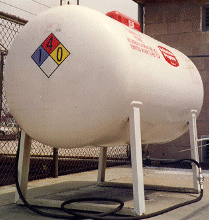
| 4b. Pressure Vessels (SSES Ch. 4.4) • Cylindrical Pressure Vessels • Spherical Pressure Vessels • Deformation of Pressure Vessels |
Back | Index | Next |
| Spherical Pressure Vessels
Due to the 3D symmetry of thin-walled spherical pressure vessels, stress is uniform (the same) throughout. The spherical stress sS is determined by cutting the sphere in half and applying equilibrium:
|

 Spherical Stress FBD. |
Deformation of Pressure Vessels
| |||||||||||||||
| Top | Back | Index | Next |